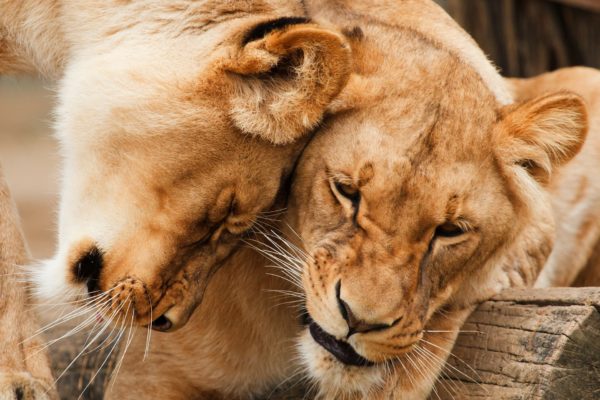The lion is perhaps the most recognizable big wildcat. Lions are characterized by muscular, deep-chested bodies, a large rounded head, short neck, and legs. Males differ from females because of their prominent dark-colored males. In most Disney movies such as The Lion King, Madagascar, The Wild, and The Chronicles of Narina. So what fascinates us so much about lions that we branded them the King of the Jungle?
1. A History of Wild lions

It is believed that lions appeared on earth nearly six hundred years ago and spread out to almost every continent in the world. It is known that lions existed in Europe and North America. The European lion is rendered in art, such as the Grotte Chauvet (thirty-two thousand-year-old cave art), where it is depicted as a maneless but large cave lion.
In not so later times, lions were widely distributed across most of Africa, Europe, and Asia. Still, their population has declined, and increased human activity has pushed them out of their habitat. Lions now occupy roughly 20% of where they were historical. According to recent surveys, the number of wild lions might stand at thirty thousand, and this number might drop because of increased factors that threaten the wild lion.
2. The Species of Lions
Lions belong to the big cat family of Felidae, in the subfamily of Pantherinae, genus Panthera and the subspecies Panthera leo. As regards to modern lions, there have long been two general classifications of subspecies of lion, Panthera leo leo (the African Lion) and Panthera leo persica (the Asiatic lion).
This was before a publication by the Cat Specialist Group, a part of the International Union for Conservation of Nature that suggested that the lions from West and Central Africa are more closely related to Asian lions compared to lions from eastern and southern Africa. The group reclassified lions into two new subspecies: Panthera leo leo (the Northern subspecies) and Panthera leo melanochaita (the Southern subspecies). Panthera leo leo is the lion populations in Central Africa, West Africa (West African or Senegal lion), India (Asiatic lion), and extinct populations formerly found in North Africa (Barbary lion), south-eastern Europe, the Middle East, the Arabian peninsula and south-western Asia. Panthera leo melanochaita includes lion populations from southern parts of Africa (Katanga lion and the Southeast African lion) and East Africa (Masai lion and Ethiopian lion).
3. Physical Characteristics of Lions

The reason lions stand out from other wild cats is most probably because of their bodies. Lions are of the largest of the wild cats after tigers. Lions can weigh from 110 to 272 kilograms, reach lengths of up to 137 to 250 centimeters, and can live up between twelve to sixteen years. Lions’ bodies are muscular and are adapted for strength and short bursts of high speed. For camouflage, lions have a consistent tawny coat that helps them blend in with the grass across the savannah. The shoulders and forepaws of lions are huge and sturdy so it can take down larger prey.
Male lions are distinct from females because of the presence of a mane. Manes range from blonde to dark-colored. They may also be small or impressively large, dependent on the lion and/or the climate in question. One reason that scientists believe that the purpose of manes was to protect the lion’s neck during fights. However, Craig Parker of the Lion Project in the Serengeti, Tanzania, after conducting an interesting experiment with life-size male doll lions, concluded that manes might most likely be a status symbol over every protection. From the experiment, the lionesses tried to mate with dolls that had bigger and darker manes, and other male lions avoided them, opting to attack the dolls with blonder manes. When consulting their field data, Parker and his colleagues noticed that dark-manned males tended to be older than the others, have higher testosterone levels, heal better and sire much more resilient cubs.
Young lions have pink noses that start getting black spots as they mature till they blacken entirely in old age.
4.The Lion Pride

An interesting fact about lions is that they are the only wild cats that live in groups. The African lion pride may comprise around three males and ten to twelve females and their young. This is, however, not the standard composition as prides may be smaller or even larger, with National Geographic reporting up to forty lions.
Related or unrelated males form coalitions to compete for tenure in pride, which is normally the duration of a breeding cycle of two to three years. Competition for tenure is high, and solo or less numbered coalitions may lose tenure to larger ones, with the latter maintaining tenure for longer and over multiple prides. Taking over a pride happens when cubs are slightly over eighteen months old. In a takeover, many cubs under a year old may be killed, which is a way of the incoming males used to assert their dominance. Typically then most females lose their cubs within a period of about a month. In this way, males assure their paternity and lionesses come into estrous soon after the takeover. Lion prides also exhibit group territorial behavior with larger prides occupying better climatic areas such as estuaries and watering points where there is more food, leaving smaller ones in the peripheral.
5. Threats to the King of Beasts
Human beings, no surprise, are the largest threat to wild lions. Indiscriminate killing, prey base depletion, habitat encroachment, and trophy hunting are some main threats to lion numbers. Human-wildlife conflict is also a threat to these wild cats. To curb this threat, governments have restricted hunting, put in place measures to minimize human-lion conflict, conserve habitat and wild prey base, and measures to increase lion habitat and wild prey base.

































